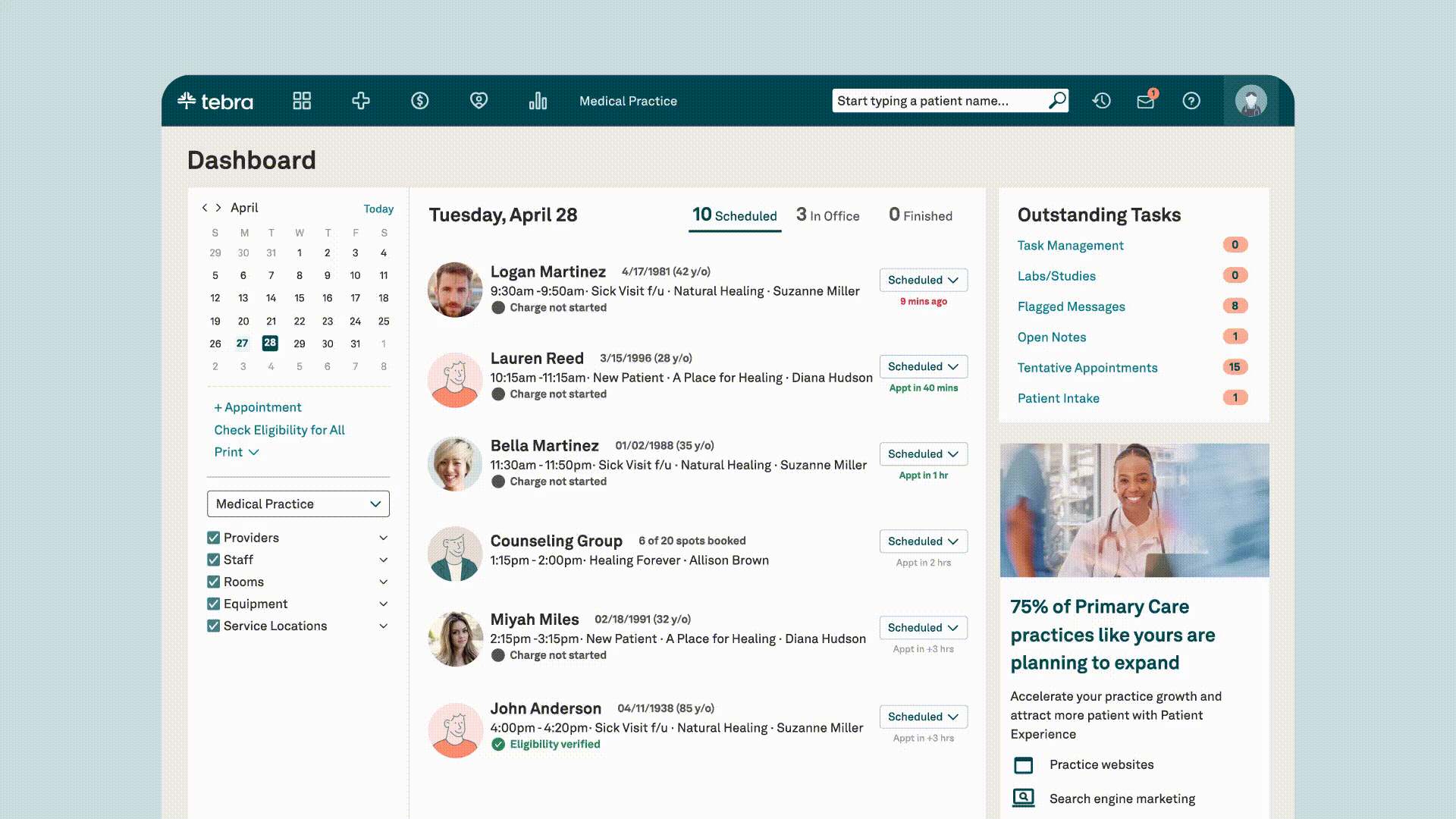Electronic health record (EHR) and electronic medical record (EMR) software enables healthcare providers to securely manage patient health information, streamline prescriptions, and enhance clinical workflows. Research confirms these systems help improve care outcomes.
Despite these advantages, independent practices increasingly struggle with EHR documentation burden. Time spent navigating complex systems reduces patient interaction, contributing to provider burnout and revenue decline.
This article outlines practical strategies for independent practices to minimize EHR/EMR documentation time while maximizing efficiency and patient care quality.
What is the meaning of EHR documentation?
EHR documentation refers to the process of digitally recording patient health information, including medical history, diagnoses, treatments, and prescriptions, within an EHR.
This digital documentation replaces traditional paper charts and notes, and allows different healthcare providers and organizations to easily share, update, and analyze patient data. It's meant to make practice workflows more efficient. But it's not always successful at doing so.
“For many providers, EHR documentation significantly cuts into patient interaction time.”
In a Tebra survey about patient interaction time, providers reported that, for every patient visit, they spend an average of 9 minutes charting notes in their EHR software and 18 minutes on direct patient interaction. Below, we'll cover:
- How much time providers really spend on documentation versus patient interactions
- The impact of the EHR documentation burden on patient care
- Tips to optimize EHR documentation time
| Looking for an EHR that won’t slow you down? This guide helps you find one that supports your care — not your paperwork. |
3 main factors behind high documentation time
Why does it take so long to chart notes? A few factors significantly influence the EHR documentation burden for clinicians:
- System usability issues: Challenging software interfaces slow down charting or result in redundancies and errors.
- Inefficient processes: Redundancies, such as having both paper and digital intake, can become time-consuming and confusing. So can lack of standardization, such as in unstandardized carry-over notes, especially for chronically ill patients who may have multiple providers.
- Lack of training and support: Inadequate training contributes to EHR inefficiencies and creates friction in the electronic documentation process.
These and other factors can have serious consequences for patients and providers alike. EHR systems are still essential to running a successful practice. However, if implemented poorly, they take time away from patient care and can hurt outcomes.
Clinicians spending less time alone with patients is enough to negatively affect healthcare outcomes and satisfaction. So how can clinicians and staff in an independent practice reduce EHR documentation burden?
Providers spend 9 minutes on EHR documentation per patient
On average, providers spend approximately 9 minutes on charting notes for each patient. Here's how it breaks down by specialty:
- Primary care providers: 60% spend 6 to 20+ minutes charting notes
- Mental health providers: 68% spend 6 to 20+ minutes charting notes
- Specialists: 45% spend 6 to 20+ minutes charting notes
- Nurse practitioners: 80% spend 6 to 20+ minutes charting notes
When it comes to time with patients, providers reported spending an average of 21 minutes with new patients and an average of 15 minutes with returning ones. This means that for every hour providers spend with patients, they spend about 30 minutes on EHR documentation. This can have an enormous impact on individual clinicians, on the practice as a whole, and on patient care.
The impact of EHR documentation on patient care and practice revenue
EHR/EMR documentation can create a challenging dilemma for healthcare providers. While legally required and essential for quality patient care (and protection against potential medical malpractice suits), excessive documentation directly reduces patient interaction time.
Tebra's survey reveals 72% of providers value patient interaction for job satisfaction, yet 82% experience burnout during appointments. EHR documentation demands, coupled with pressure to increase patient volume, intensify this burnout.
The financial consequences are equally concerning. When clinicians take more time on EMR/EHR documentation than patient care, practices face inaccuracies, diminished trust, and higher patient turnover — all affecting your bottom line.
Properly implemented EHR systems can actually solve these challenges by streamlining workflows and eliminating redundancies. Understanding documentation pain points is essential to creating balance between thorough record-keeping and quality patient care.
How to improve EHR/EMR documentation and reduce burden on your independent practice
While EHRs offer numerous benefits, they can also introduce new challenges, particularly when it comes to documentation. Independent practices often grapple with the time-consuming nature of EHR data entry, which can take away from patient care.
However, by implementing the right strategies and selecting the right EHR platform, you can improve efficiency and reduce the documentation burden.
Choosing the right EHR/EMR
Good documentation processes begin during the EHR system evaluation phase. Follow these tips to build your processes from the ground up, or improve your current ones:
- Complex and challenging EHR software can significantly slow down documentation. Prioritize a user-friendly interface and intuitive design.
- Look for customization options that align documentation workflows with your needs without sacrificing compliance.
- Be wary of common issues like option overload, complex EHR workflows, and poor carry forward options, which all contribute to a higher documentation burden.

Optimize your EHR workflow
Quick tips to improve efficiency in EHR/EMR documentation
- Utilize templates: Streamline data entry by utilizing pre-built templates for common visit types, such as routine check-ups or specific conditions. This ensures consistency, reduces clicks, and saves valuable time.
- Leverage voice recognition: Dictate notes directly into the EHR using voice recognition software, freeing up your hands for patient interaction and reducing the time spent typing.
- Master keyboard shortcuts: Become familiar with keyboard shortcuts within your EHR system to quickly navigate between fields, add common entries, and complete tasks more efficiently.
- Document in real time: Encourage clinicians to document during or immediately after patient encounters to ensure accuracy and save time. This eliminates the need for time-consuming catch-up sessions at the end of the day. An EHR system compatible with mobile devices, tablets, or in-exam-room workstations is essential for effective real-time documentation.
- Implement structured data entry: Standardized EHR documentation templates and forms provide a framework for data entry that guides clinicians through the process. Focus on documenting essential information, using clear and concise language.
Reduce EHR documentation errors
While streamlining EHR/EMR workflows is critical, it's equally important to minimize errors in EHR documentation. Inaccurate or incomplete medical records can compromise patient safety, lead to billing issues, and even create legal challenges.
- Understand EHR documentation requirements: Common errors include failing to meet specific EHR documentation requirements. These requirements, often mandated by regulatory bodies or for billing purposes, ensure that patient records are complete, accurate, and legally sound.
- Prevent copy-and-paste errors: The copy-and-paste function (CPF) in clinical documentation improves efficiencies, but it’s important to ensure information copied and pasted is accurate and easily identifiable.
- Prepare for EHR downtime: Beyond everyday documentation challenges, independent practices must also be prepared for unexpected disruptions. EHR downtime, whether planned or unplanned, necessitates clear procedures for documenting patient information.
Download your free resource now
Access it instantly — just complete the form

Ensure data integrity in EHR documentation
Implementing a clear process for correcting mistakes in the EHR while maintaining an audit trail is crucial for ensuring documentation integrity and accuracy. When clinicians or staff identify errors, they should fix them transparently, preserving the original entry and clearly marking the correction. This approach not only ensures the medical record remains complete but also makes it easier to prevent similar errors in the future.
Organizing documentation chronologically is equally important. Chronological order makes it easier to review and understanding the patient journey, and to quickly grasp the progression of care, treatments, and outcomes.
This sequential approach ensures that all members of the care team — including those in different healthcare organizations or facilities — can efficiently access and comprehend the most up-to-date information. This leads to better interoperability, more informed clinical decision-making, and stronger continuity of care.
Invest in EHR training and support
Investing in comprehensive training and ongoing support is crucial for maximizing the benefits of your EHR system. A well-designed EHR should offer continuous learning opportunities to help both established and new providers navigate the ever-changing regulatory landscape. This education ensures that your team can fully leverage the system's full features to reduce documentation burden.
Additionally, exploring case studies of similar practices that have successfully increased their efficiency can provide valuable insights. These examples often reveal small, actionable tweaks that your practice can implement to streamline back-office processes and improve overall documentation workflows.
Select a modern EHR solution
While legacy EHR software typically relies on manual processes for data entry, appointments, charting, and billing, modern health information technology solutions like Tebra’s EHR streamline workflows through automation, alerts, and integrations. These features make the entire system faster and easier to navigate.
“Modern solutions like Tebra’s EHR streamline workflows through automation, alerts, and integrations.”
Modern EHR systems like Tebra's provides customized template options to accelerate chart creation and note-taking. It may also include automatic transcription features to quickly summarize patient queries.
Furthermore, modern EHR systems integrate seamlessly with other aspects of your practice, such as scheduling calendars and appointment reminders, enhancing your overall operational efficiency.
Ensure privacy and security
While security measures are essential for protecting patient data, they can sometimes add complexity to the documentation process. Following strict security protocols protects patient information and maintains compliance.
When documenting in an EHR, complying with the Health Insurance Portability and Accountability Act (HIPAA) and keeping protected health information (PHI) secure is crucial.
This involves implementing robust technological safeguards, such as:
- Encryption
- Multi-factor authentication
- Regular security audits
Physical safeguards, like secure server rooms and controlled access to workstations and mobile devices, are also important.
Complex security processes, while essential for protecting patient data, can slow down workflows and add complexity to the documentation process. The challenge lies in achieving robust security with usability to minimize the burden on clinicians. A modern, robust EHR system should help your practice balance both.
| Love content like this? Join thousands of independent providers who receive our weekly newsletter with tips on running a more efficient, profitable practice. Sign up for the newsletter. |
Foster a culture of continual improvement
Reducing the EHR documentation burden is an ongoing process that requires constant attention and refinement. While implementing the strategies above can lead to significant improvements, it's vital to establish a culture of continual improvement within your practice.
This approach involves regularly assessing your documentation workflows, gathering feedback from clinicians and staff, and staying informed about new EHR features and best practices. By doing so, you can adapt to changing regulations, technological advancements, and practice needs. This will ensure that your EHR documentation processes remain as efficient and effective as possible over time.
Boost EHR efficiency with more insights
Tebra’s 2024 survey on patient interaction time highlights current challenges providers face regarding charting documentation and building patient relationships.
By prioritizing user-friendly EHR systems, optimizing workflows, and investing in ongoing training and support, independent practices can overcome documentation challenges, reduce administrative burden, and ultimately dedicate more time to what matters most: providing exceptional patient care.
You might also be interested in
- How to Clean Up & Manage Your EHR Inbox – Discover tips to organize your inbox, reduce message overload, and boost team productivity.
- EHR Implementation Checklist for Your Independent Practice – Use this step-by-step checklist to ensure a smooth, stress-free rollout of your new EHR system.
- Want to see how a streamlined EHR can save your team time? Book a free demo and get a firsthand look.
- Current Version – Aug 19, 2025Written by: Jean LeeChanges: This article was updated to include the most relevant and up-to-date information available.
- Jul 01, 2025Written by: Jean LeeChanges: This article was updated to include the most relevant and up-to-date information available.
- Mar 29, 2025Written by: Jean LeeChanges: This article was updated to include the most relevant and up-to-date information available.







